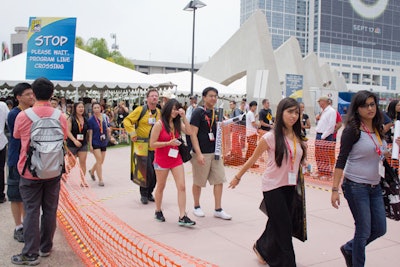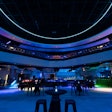
What's the first word Comic-Con's devoted attendees and exhibitors often use to describe the show? Crowded. The buzzy event is the largest of its kind in the world, and it quickly sells out annually, having hit attendee and exhibitor capacity back in 2007. This past show, which wrapped earlier this month, sold out in about one hour and 20 minutes, resulting in the scrolling waiting list the show generates every year—and, as always, massive crowds.
Having reached its self-imposed attendance limit at the San Diego Convention Center six years ago, organizers have had to cap attendance at approximately 125,000 each year since. (Attendance varies slightly year by year depending on floor configuration.) The group considered proposals to move to L.A. or Anaheim after the 2012 lease was up, but decided to stay in San Diego through 2015. For scale, the first show was held in 1970 and drew 300.
So how does the group manage the crowds? With laser-beam-like focus on the details.
The show's director of marketing and public relations, David Glanzer, explained that approaches to crowd control include the transformation of certain corridors of the convention center to one-way avenues for pedestrian traffic to limit bottlenecking in the meeting areas. He explained that there is a division of the team dedicated to handling lines. "We literally use every square inch of the facility, and we do a pretty good job of being able to move people upstairs and back down again," said Glanzer, explaining that logistic precision is the key to the show's crowd-control success.
Comic-Con also makes uses of venues like the Hilton Bayfront and massive parking lot of Petco Park to hold programs that ease crowding at the convention center itself. Diffusing the number of people in the building at any given time helped up the total attendance to about 130,000 since last summer, a small bump, but significant to those would-be attendees whose participation dreams came true. (This year's attendance number will be determined weeks after the show, following an internal audit.) In all, about 60 hotels in the San Diego area house participants and help ease the crush, and this year for the first time, a 24-hour shuttle service helped move guests around the city.
Apart from crowd-control challenges, there are benefits to the show being so oversold (aside from the obvious revenue generation): not wanting to taunt and alienate fans who couldn't get tickets, organizers opt against advertising. "So while we once had an advertising budget, that’s almost all been eliminated as not necessary," Glanzer said.
Going forward, the show might get some relief from its vigilant crowd-control efforts, as the city of San Diego and its convention center have proposed an expansion, which seems to be moving along. "Fans [don't] want us to move from San Diego, and the mayor, local hoteliers, and convention center" are all involved in the effort to keep the show, Glanzer said. "[Comic-Con itself] is a little city for one weekend of the year every year."



















